Entranced by a garden created by works in three different eras – a Baroque garden, a romantic park, and a Deco garden from the 1920s – Prince von Metternich summed up one of the most important villas in the Lucchesia as “a truly divine place”.
The garden around the villa, once owned by the Buonvisi family, and the so-called “dell’Orologio” building took on a new baroque-style faciesin the late 17th century. Main attractions are: a grotto/theatre of stone and calcareous concretions, with a semicircular basin in front of it, which partitions off the space behind the palazzo; a fishpond, a rectangular basin surrounded by high box and yew hedges, ending in Leda’s nymphaeum, with figures representing the Arnoand the Serchiorivers; a lemon garden, housing more than 200 potted citrus plants; and a famous open-air theatre with three terracotta statues of Colombina, Pantalone and Balanzone, in tribute to the Commedia dell’Arte. In the early 19th century, Elisa Baciocchi – Princess of Lucca and Piombino, and Napoleon’s sister – purchased and enlarged the property by incorporating the Bishop’s villa. She revamped the estate with an august, neoclassical look, and a 17th-century highlight garden, a vast English-style park. Irregular lawns and now-you-see-it, now-you-don’t views alternate to create a varied scene that, lower down, ends with a lake surrounded by centuries-old specimens of Liriodendron tulipifera, the tulip tree. Further changes were made in the 1920s, when French landscape architect Jacques Gréber created a Deco garden for the Pecci Blunt family. This proved to be the final precious piece of a wonderous puzzle: from the majestic romantic park to the refined Islamic-inspired water garden and its sophisticated colour combinations, running from purple bougainvillea to gold-mosaiced channels.
Highlights
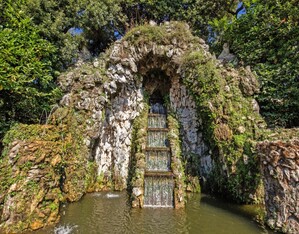
Nymphaeum
Behind the villa lies a semicircular basin, a water scene whose focal point is an artificial stone grotto with limestone concretions, topped with zoomorphic emblems of the city of Lucca (a lion and a panther).
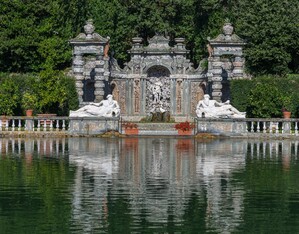
Fishpond
Bordered by high box hedges and yew trees, this rectangular basin ends in two apses framing two fountains: on one side, the Nymphaeum of Leda and the swan, in a niche framed by caryatids, with the figures of the rivers Arno and Serchio as overtures; on the other side, a circular cupped fountain emerges from an anthropomorphic shaft depicting the Three Graces.
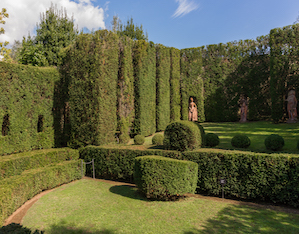
Open-Air Theatre
This extraordinary specimen of plant architecture, featuring a closed, elliptically-shaped hall enlivened by terracotta statues from the Commedia dell’Arte, was made in the late 17th century. The stage space is outlined by a succession of gently-inclined wings; topiary forms simulate stage lights, the conductor’s podium, and prompter’s box. Niccolò Paganini, who resided in Lucca when it was a Napoleonic Principality, once performed here.
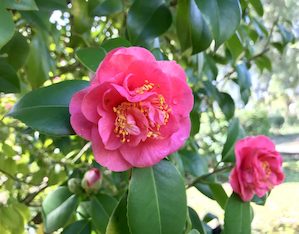
The Avenue of Camellias
Winding along a former streambed, this avenue is one of the most romantic places in the entire park, especially in March when the flowers are in full bloom. The villa currently houses over forty varieties of Camellia japonica, which first arrived in Tuscany in the early 19th century.
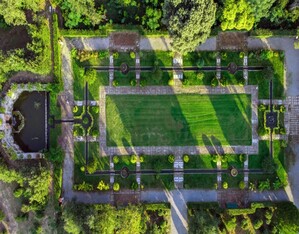
Deco Garden
Characterized by geometric shapes and reworked Hispano-Moorish garden archetypes, water is the generative element of this garden. Criss-crossed by slim canals and slender fountains, it culminates in an exedra decorated with golden tiles; the splashes of colour continue in the swimming pool and changing rooms.
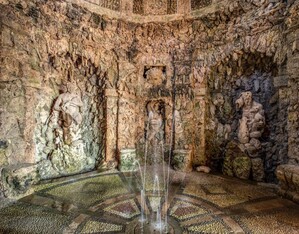
Archbishop’s Garden Grotto
Preceded by a belvedere portico, the walls of this circular space are covered in tufa rock and fossil concretions; the geometric frame of the two-tone mosaic tiles is reflected in the radial design of the dome; the floor is divided into eight segments. Three major exedras emerge from this circular form, which has a Pan figure at its centre; four minor niches pick out a radial cross.
Find out more
Landscape architects
For many years, this French architect worked in North America. Rather than creating gardens, he was interested in landscape architecture and urban design. He was a member of the “City Beautiful” movement.
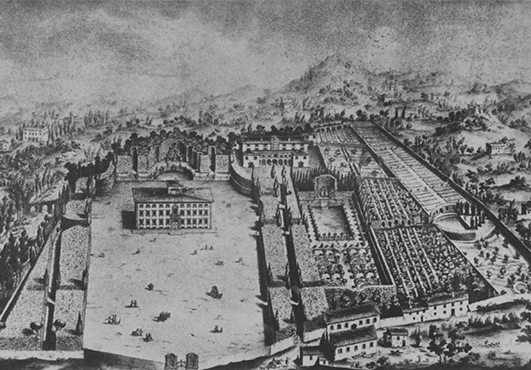
 Villa Reale di Marlia
Contacts
Villa Reale di Marlia
Contacts
 Villa Reale di Marlia
Opening times and prices
Villa Reale di Marlia
Opening times and prices
Opening hours
open every day from 10.00 am to 6.00 pm
Pricing
Adults
Park € 9,00 Park + Villa € 14,00 Reduced (children from 14 to 17 years old, groups of min. 10 people, adults>65 years old, FAI and TOURING CLUB members, CTTNORD subscribers, ADSI members, high school school groups + free accompanying persons) Park 7 € Park + Villa 12 € Reduced School groupsup to the third grade (accompanying persons free entrance) Park 5 € Park + Villa 10 €
Free
Children up to 13 years (excluding groups), Companions, Guides, Drivers, Disabled persons
Admission for children from 6 to 13 years old with BotanicalTreasure Hunt via official Villa Reale app € 5,00
Season ticket € 55,00
 Villa Reale di Marlia
How to get there
Villa Reale di Marlia
How to get there
Address
Via Fraga Alta, 2
55014, Marlia (LU)
Latitude: 43.898863
Longitude: 10.5521265
How to arrive by road
From the A11 motorway towards Florence take the Lucca est exit, follow the signs for Abetone for 6 km and follow the signs for Matraia and Villa Reale.
How to arrive by train
From Florence’s Santa Maria Novella train station, take the regional train to Lucca and then bus line 59 to the park entrance.
How to arrive by bus
Line 59 from Lucca: the bus leaves from Piazzale Verdi, passes by Lucca Station, and makes all the stops outside the walls until it reaches the entrance to the park. The entrance ticket to the park is discounted for those who present the public transport ticket.
Additional directions
Distance from Pisa Galileo Galilei Airport: 43Km Distance from Florence Amerigo Vespucci Airport: 70Km
 Villa Reale di Marlia
Services/Accessibility
Villa Reale di Marlia
Services/Accessibility
Services
- Duration of the visit: about 3-4 hours
- Target group: groups of children aged 6 to 13 years old
- Ticket: 5 € per child, free for teachers
- Transport and packed lunch: paid for by the school
Dogs are allowed in the park only on a leash under the supervision of the owner who is directly responsible. It is mandatory to collect any needs. Animals are not allowed in the villa.
Free outdoor parking near the entrance.
Café Villa Reale offers the opportunity to relax in the gardens with cool drinks and a selection of food.
Read the Regulation of the Park and the Villa
 Villa Reale di Marlia
Private events
Villa Reale di Marlia
Private events
 Villa Reale di Marlia
Itineraries
Villa Reale di Marlia
Itineraries
You could find the garden in these itineraries
 Favorite saving result
Favorite saving result
 Warning!
Warning!
You've have to sign up or sign in to add this element to your favorites.
